Xiaomi Aqara E1
By Aqara
The radiator thermostat can be used with the majority of water radiators such as radiators, towel warmers or even underfloor heating. It takes readings from external Aqara sensors and adjusts the heating power accordingly.
This page has been visited ... times
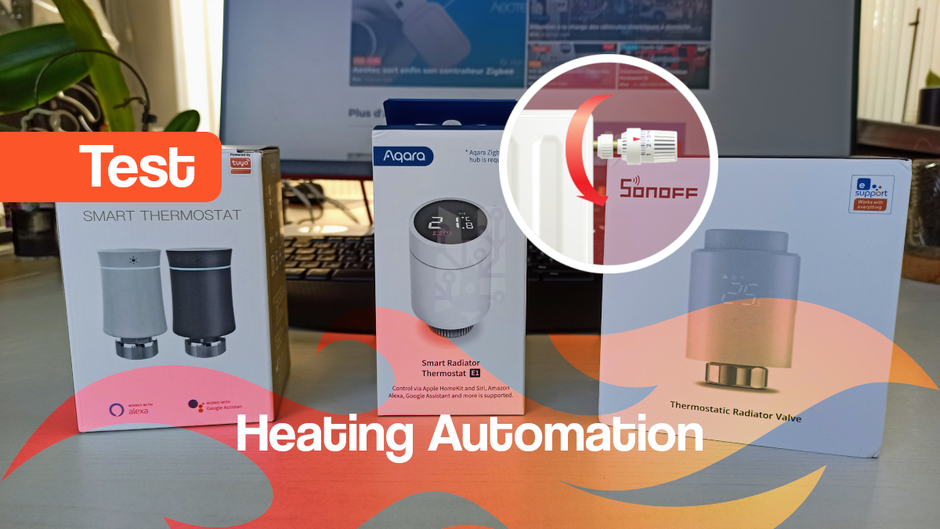
Since last year the government has been advising us to heat our homes to 19°C to save energy. Even more recently, a subsidy is offered, and as is often the case to benefit from it, it must be applied by a professional. Unfortunately this type of installation is often expensive. In the meantime, I offer you a tutorial on the operation of 3 thermostatic faucets using the Zigbee protocol. How much does it cost to homemate your heating using Zigbee?
This test aims to compare 3 thermostatic faucets and help you choose according to your needs. This comparison was carried out on a home-assistant instance and integrated using Zigbee2mqtt.
Secondly, I will tell you about the cost of such an installation with a home automation box.
The comparison concerns 3 Chinese-made thermostatic heads, the integration presented is on homeassistant. So what are these faucets:
Let’s start by detailing these various products
Xiaomi Aqara E1 official information
The Xiaomi Aqara E1 is very well made, its price is around €45 access to battery change, the onclick function of the screen, the settings everything is well thought out, it is the only one to deliver the thermostatic head with batteries but it is also the most expensive. On the installation side, as you can see in the photo, it comes with adapters, instructions, in short, everything you need. Personally, I installed it without any adapter on a traditional radiator. The reading of the screen remains exceptional however it will not be suitable for all situations, in use I realize that many radiators can have the tap camouflaged by a corner of the wall and in this In this case, the data could not be read properly.
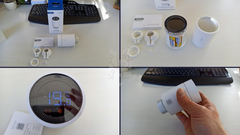
The thermostat can be used with the majority of water radiators such as radiators, towel warmers or even underfloor heating. It takes readings from external Aqara sensors and adjusts the heating power accordingly.
| Power supply | 3V ⎓ (2 × 1.5V AA) INCLUDED |
| Battery life | 1 year |
| Communication | Zigbee 3.0 IEEE 802.15.4 |
| Maximum Zigbee output power | <10 dBm |
| Zigbee operating frequency | 2405-2480 MHz |
| Operating temperature | 0°C ~ 40°C |
| Operating humidity | 0 ~ 95% RH, non-condensing |
| Dimensions | Ø 57×89 mm |
| Threaded connection | M30 × 1.5 mm |
A multitude of functions are available to us, there are so many that we no longer know where to put our heads among the important functions we find:
The rest is of less importance.
Currently the Aqara thermostatic head does not record the current operating state of the module when it is heating or not heating and this is very annoying because it is an essential function for configuring automations.
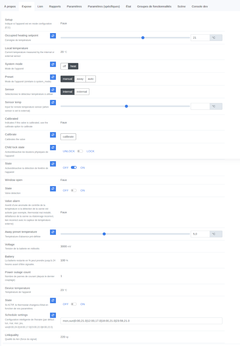
On the other hand, a function that could have been integrated is a boost mode when starting heating as is the case with the Moes ZTRV-BY-100, but it is a function that we can implement with automation.
Finally, there is also a lack of an auto mode in the thermostat mode, which means that you will not be able to select auto mode in the home assistant thermostat interface, however this module still includes a program mode with various schedules to configure.
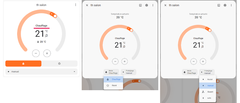
While waiting for the integration to be perfect in Zigbee2mqtt or Zha, this module does not allow you to fully exploit the automation functions of Home Assistant unless perhaps you create a suitable template, but that’s it. another story.
Official information Sonoff TRVZB
Delivered in a high-end case, this thermostatic faucet comes with a whole range of adapters, the whole thing is carefully crafted with good manufacturing quality and all without frills. Access to the battery compartment is hassle-free and the assembly system is well thought out. Be careful though, you need 3 batteries to make it work. This is the only module to offer a display from above, at first glance it does not seem suitable but this is not the case, everything is displayed and is clearly readable.
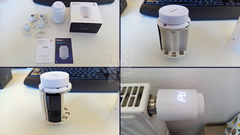
However of the 3 adapters it is the one which is the poorest in information, but regardless the most important functions will be.
The onclick and wheel button provides modularity similar to the Xiaomi Aqara E1. Finally, it is priced at €32 and you will be able to see a little further down that it is rich in functionality.
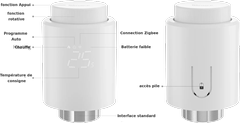
| Model | TRVZB |
| Color | White |
| Wireless connection | Zigbee 3.0 |
| Input | 4.5 V⎓ 3 x 1.5 V AA batteries (NOT INCLUDED) |
| Net weight | 154 g |
| Battery model | 1.5V AA LR6 alkaline battery |
| Case Material | PC |
| Threaded connection | M30x1.5mm |
| Temperature adjustment range | 4°C to 35°C |
| Product dimensions | 59.4 × 59.4 x 95 mm |
Unlike the other two thermostats, you will need to install it on a radiator to be able to include it in your Zigbee network, otherwise an error will appear.
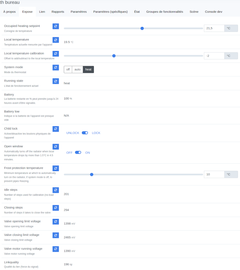
A less important range of functions in Z2M than the Xiaomi Aqara SRTS-A01 or the Moes ZTRV-BY-100, but it does not forget any important functionality unlike the Aqara, like the thermostat mode (off, manual, auto ) and the current operating state which will allow you to fully control these functions in HA. In my opinion it just lacks the Boost mode (easily configurable in Automation).
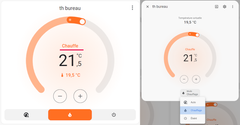
As described above, the Sonoff TRVZB offers control of all the interesting functions in the Home Assistant HVAC thermostat interface.
Let’s finish with the Moes thermostat
Official information Moes ZTRV-BY-100
We are clearly dealing with a white label of the Tuya range, unlike Xiaomi or Sonoff Moes markets products under its own brand but distributed as a white label for other brands and integrating the Tuya protocol. you will realize that the manufacturing quality is below Xiaomi and Sonoff. However its curve and its silky touch are successful but that’s not everything.
The Moes ZTRV-BY-100 has full lighting but a little too powerful, but it’s not that bad, like the Xiaomi Aqara E1 the display is on the side and in quite a few cases it will not be visible or readable. Unlike the other two, the Moes offers a touch interface and not a button with click/wheel function.
I find this interface less easy to use.
Also accessing the batteries is the trickiest of the three when it is not attached to the radiator. Once in place, if you rotate the thermostat slightly you will find yourself with it in your hand.
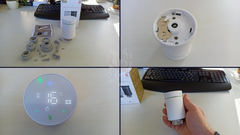
Last point, the battery lock is more than cheap, frankly the steel is as thick as a sheet of cigarette paper and the latch as a toothpick.
If you don’t want to break anything you’ll have to go about it delicately and that’s not for everyone, I know what I’m talking about. 🥹
| Power supply | 3 V, 2 AA batteries (NOT INCLUDED) |
| Color | White |
| Technology | Zigbee |
| Maximum stroke | 4.5 mm |
| Precision | ± 0.5°C |
| Adjust the temp. Range | 5~45°C |
| Temp. display Range | 0~70°C |
| Ambient temperature | 0 ~ 45°C |
| Ambient humidity | 5 ~ 95% RH (non-condensing) |
| Storage temperature | -5 ~ 45°C |
| Sync Error | < 1% |
| Protection class | IP20 |
| Buttons | capacitive touch buttons |
| Included in the packaging | 1x Radiator thermostat 1x User guide 1x RA adapter 1x RAV adapter 1x RAVL adapter 1x Comap adapter 1x T + A Herz Adapter 1x Herz Adapter |
The Moes ZTRV-BY-100 is the one that displays the most information on its dial, many functions are present such as:
This module looks complete and it is, you can see from the number of fairly impressive function updates that Tuya has worked well on its firmware.
For the moment Does not offer OTA updates
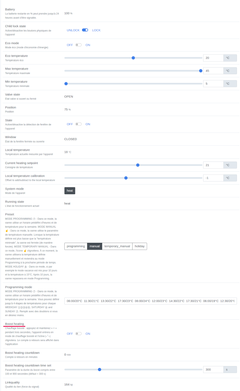
Tuya has well integrated the operating status so important for home assistant but in the device mode you will only have heating mode no off or auto mode.
So I’ll let you think about how to turn off this module outside of the heating period and yes it risks eating up the battery.
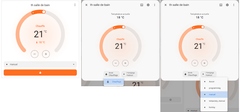
However, you can select the very complete but also complex programming mode in the thermostat interface.
The cost is calculated on the purchase of 5 thermostatic faucets and a home automation box running on Home Assistant with pre-installed software. Why 5 taps? quite simply because soon a video of home automation of an apartment will see the light of day.
Here is the selected material:
Let’s start with a purchase of 5 taps Sonoff TRVZB, a Nodon dry contact module and a box equipped with Home Assistant Green, it will cost you €309 and for this price with good configuration you will be able to save money.
The Haade team will soon broadcast a video on home automation of an apartment and calculating the cost of energy. Following this full-scale test I would be able to calculate a return on investment for you.
I had to make a choice, which was not so easy to make because despite their differences these modules do relatively similar work.
Here is a full-scale test which could be more complete, keep in mind that the Xiaomi Aqara SRTS-A01 is difficult to control by automation therefore the return on investment is certainly longer. The manufacturing quality of the Moes leaves a little to be desired; the absence of the extinguishing mode will make this module more energy intensive.
And to finish our big winner of the contest the Sonoff TRVZB good manufacturing quality, a vertical visual that is fully configurable and controllable in Home Assistant for maximum savings for years to come.
Copyright © 2025 Haade 🎉 by Nicoxygen
Comments